Nature-Based Solutions in Workplace Settings: A Scoping Review on Pathways for Integrated Quality, Environmental, Health, and Safety Management
Abstract
1. Introduction
2. Background
2.1. Occupational Environments and Challenges
2.2. Existing Evidence on NbS Benefits
3. Methodology
4. Results and Discussion
4.1. Research Landscape and Emerging Trends
4.2. NbS Benefits on Workplace
4.2.1. Psychophysiological Benefits
4.2.2. Psychosocial and Motivational Outcomes
4.2.3. Organizational and Economic Findings
4.3. NbS Challenges and Opportunities
4.3.1. Challenges to Implementing NbSs
4.3.2. Opportunities to Implement NbSs
5. Limitations and Future Research
6. Conclusions
Supplementary Materials
Author Contributions
Funding
Institutional Review Board Statement
Informed Consent Statement
Data Availability Statement
Conflicts of Interest
References
- Debele, S.E.; Leo, L.S.; Kumar, P.; Sahani, J.; Ommer, J.; Bucchignani, E.; Vranić, S.; Kalas, M.; Amirzada, Z.; Pavlova, I.; et al. Nature-based solutions can help reduce the impact of natural hazards: A global analysis of NBS case studies. Sci. Total Environ. 2023, 902, 165824. [Google Scholar] [CrossRef]
- Almenar, J.B.; Elliot, T.; Rugani, B.; Philippe, B.; Gutierrez, T.N.; Sonnemann, G.; Geneletti, D. Nexus between nature-based solutions, ecosystem services and urban challenges. Land Use Policy 2021, 100, 104898. [Google Scholar] [CrossRef]
- Ling, J. The application of natural elements in interior landscape design and its principal analysis. Res. Archit. Dev. 2021, 5, 12–15. [Google Scholar] [CrossRef]
- Petrova, S.; Velcheva, I.; Nikolov, B.; Angelov, N.; Hristozova, G.; Zaprjanova, P.; Valcheva, E.; Golubinova, I.; Marinov-Serafimov, P.; Petrov, P.; et al. Nature-based solutions for the sustainable management of urban soils and quality of life improvements. Land 2022, 11, 569. [Google Scholar] [CrossRef]
- Gillis, K.; Gatersleben, B. A review of psychological literature on the health and wellbeing benefits of biophilic design. Buildings 2015, 5, 948–963. [Google Scholar] [CrossRef]
- Hutson, J.; Hutson, P. Neuroinclusive workplaces and biophilic design: Strategies for promoting occupational health and sustainability in smart cities. Glob. Health Econ. Sustain. 2023, 1, 549. [Google Scholar] [CrossRef]
- Ríos-Rodríguez, M.L.; Testa Moreno, M.; Moreno-Jiménez, P. Nature in the office: A systematic review of nature elements and their effects on worker stress response. Healthcare 2023, 11, 2838. [Google Scholar] [CrossRef] [PubMed]
- Gritzka, S.; MacIntyre, T.E.; Dörfel, D.; Baker-Blanc, J.L.; Calogiuri, G. The effects of workplace nature-based interventions on the mental health and well-being of employees: A systematic review. Front. Psychiatry 2020, 11, 323. [Google Scholar] [CrossRef]
- Bratman, G.N.; Anderson, C.B.; Berman, M.G.; Cochran, B.; de Vries, S.; Flanders, J.; Folke, C.; Frumkin, H.; Gross, J.J.; Hartig, T.; et al. Nature and mental health: An ecosystem service perspective. Sci. Adv. 2019, 5, eaax0903. [Google Scholar] [CrossRef]
- Sadick, A.M.; Kamardeen, I. Enhancing employees’ performance and well-being with nature exposure embedded office workplace design. J. Build. Eng. 2020, 32, 101789. [Google Scholar] [CrossRef]
- Alaghbari, M.A.; Beshr, B. The role of adapting green management in raising the organization’s sustainability. Inf. Sci. Lett. 2023, 12, 1501–1503. [Google Scholar] [CrossRef]
- Zhong, W.; Schröder, T.; Bekkering, J. Biophilic design in architecture and its contributions to health, well-being, and sustainability: A critical review. Front. Archit. Res. 2022, 11, 114–141. [Google Scholar] [CrossRef]
- Charisi, V.; Zafeiroudi, A.; Trigonis, I.; Tsartsapakis, I.; Kouthouris, C. The impact of green spaces on workplace creativity: A systematic review of nature-based activities and employee well-being. Sustainability 2025, 17, 390. [Google Scholar] [CrossRef]
- Collier, M.J.; Bourke, M. The case for mainstreaming nature-based solutions into integrated catchment management in Ireland. Biol. Environ. Proc. R. Ir. Acad. 2020, 120, 107–113. [Google Scholar] [CrossRef]
- Yin, J.; Arfaei, N.; MacNaughton, P.; Catalano, P.J.; Allen, J.G.; Spengler, J.D. Effects of biophilic interventions in office on stress reaction and cognitive function: A randomized crossover study in virtual reality. Indoor Air 2019, 29, 1028–1039. [Google Scholar] [CrossRef]
- Tricco, A.C.; Lillie, E.; Zarin, W.; O’Brien, K.K.; Colquhoun, H.; Levac, D.; Moher, D.; Peters, M.D.J.; Horsley, T.; Weeks, L.; et al. PRISMA extension for scoping reviews (PRISMA-ScR): Checklist and explanation. Ann. Intern. Med. 2018, 169, 467–473. [Google Scholar] [CrossRef] [PubMed]
- Bressane, A.; da Cunha Pinto, J.P.; de Castro Medeiros, L.C. Countering the effects of urban green gentrification through nature-based solutions: A scoping review. Nat. Based Solut. 2024, 5, 100131. [Google Scholar] [CrossRef]
- Spencer, T.; Munera, C.; Pizarro, V.; Lozano-Rivera, P.; Esquivel, C.; Cardona, O.D. Coastal ecosystems contribution to climate adaptation and disasters risk management in the tropical Americas. Nat.-Based Solut. 2024, 5, 100112. [Google Scholar]
- Katyal, N. Understanding about nature-based approaches for sustainable consumption, production and development. In Nature-Based Solutions in Achieving Sustainable Development Goals: Harmonizing Nature and Progress; Springer Nature: Cham, Switzerland, 2024; pp. 317–367. [Google Scholar]
- Enu, K.B.; Zingraff-Hamed, A.; Rahman, M.A.; Stringer, L.C.; Pauleit, S. Potential of nature-based solutions to mitigate hydro-meteorological risks in sub-Saharan Africa. Nat. Hazards Earth Syst. Sci. 2023, 23, 481–505. [Google Scholar] [CrossRef]
- Barman, A.; Rajak, F.; Jha, R. Integrating wetlands as nature-based solutions for sustainable built environments: A comprehensive review. Eng. Technol. Appl. Sci. Res. 2024, 14, 18670–18680. [Google Scholar] [CrossRef]
- Nehren, U.; Arce-Mojica, T.; Barrett, A.C.; Cueto, J.; Doswald, N.; Janzen, S.; Lange, W.; Vargas, A.O.; Pirazan-Palomar, L.; Renaud, F.; et al. Towards a typology of nature-based solutions for disaster risk reduction. Nat.-Based Solut. 2023, 3, 100057. [Google Scholar] [CrossRef]
- Bressane, A.; de Castro, M.V. Workplace well-being through nature-based solutions: A fuzzy framework for decision-making. Buildings 2024, 15, 117. [Google Scholar] [CrossRef]
- Callaghan, M. Interior Design Strategies for Nature-Based Features to Support Stress Reduction in Knowledge Workers; University of Manitoba: Winnipeg, MB, Canada, 2015. [Google Scholar]
- Tan, C.Y.; Rahman, R.A.; Lee, Y.S. Developing a WELL building model for office environments. Environ. Sci. Pollut. Res. 2024, 32, 13120–13139. [Google Scholar] [CrossRef]
- Klen, J. Utilizing the Nature Connection in the Work Environments. Bachelor’s Thesis, Haaga-Helia University of Applied Sciences, Helsinki, Finland, 2021. [Google Scholar]
- Aly, M.M.A. Biophilic design criteria for productivity (BDCP) in workspaces. Eng. Res. J. 2021, 172, 151–170. [Google Scholar] [CrossRef]
- Augustin, S.; Oseland, N. The Science of People and Office Design: Planning for Thinking, Discussing and Achieving; Routledge: Oxfordshire, UK, 2025. [Google Scholar]
- Al-Dmour, Y.; Garaj, V.; Clements-Croome, D. The flourishing of biophilic workplaces: ‘Second Home’ offices as a case study. Intell. Build. Int. 2021, 13, 261–274. [Google Scholar] [CrossRef]
- Al Khatib, I.; Samara, F.; Ndiaye, M. A systematic review of the impact of therapeutical biophilic design on health and wellbeing of patients and care providers in healthcare services settings. Front. Built Environ. 2024, 10, 1467692. [Google Scholar] [CrossRef]
- Andersen, L.; Corazon, S.S.; Stigsdotter, U.K. Nature exposure and its effects on immune system functioning: A systematic review. Int. J. Environ. Res. Public Health 2021, 18, 1416. [Google Scholar] [CrossRef]
- Aristizabal, S.; Byun, K.; Porter, P.; Clements, N.; Campanella, C.; Li, L.; Mullan, A.; Ly, S.; Senerat, A.; Nenadic, I.Z.; et al. Biophilic office design: Exploring the impact of a multisensory approach on human well-being. J. Environ. Psychol. 2021, 77, 101682. [Google Scholar] [CrossRef]
- Ausseil, A.-G.E.; Greenhalgh, S.; Booth, P.; Lavorel, S.; Collins, A. A novel approach to identify and prioritize the connections between nature and people’s well-being in New Zealand. Front. Environ. Sci. 2022, 10, 782229. [Google Scholar] [CrossRef]
- Barnes, M.R.; Donahue, M.L.; Keeler, B.L.; Shorb, C.M.; Mohtadi, T.Z.; Shelby, L.J. Characterizing nature and participant experience in studies of nature exposure for positive mental health: An integrative review. Front. Psychol. 2019, 9, 2617. [Google Scholar] [CrossRef] [PubMed]
- Barron, S.; Rugel, E.J. Tolerant greenspaces: Designing urban nature-based solutions that foster social ties and support mental health among young adults. Environ. Sci. Policy 2023, 139, 1–10. [Google Scholar] [CrossRef]
- Candido, C.; Marzban, S.; Haddad, S.; Mackey, M.; Loder, A. Designing healthy workspaces: Results from Australian certified open-plan offices. Facilities 2021, 39, 411–433. [Google Scholar] [CrossRef]
- Chan, S.H.M.; Qiu, L.; Esposito, G.; Mai, K.P.; Tam, K.-P.; Cui, J. Nature in virtual reality improves mood and reduces stress: Evidence from young adults and senior citizens. Virtual Real. 2023, 27, 3285–3300. [Google Scholar] [CrossRef]
- Coletta, V.R.; Pagano, A.; Pluchinotta, I.; Fratino, U.; Scrieciu, A.; Nanu, F.; Giordano, R. Causal loop diagrams for supporting nature based solutions participatory design and performance assessment. J. Environ. Manag. 2021, 280, 111668. [Google Scholar] [CrossRef]
- Demirkol, A.; Önaç, A. Integrating biophilic design elements into office designs. Ain Shams Eng. J. 2024, 15, 102962. [Google Scholar] [CrossRef]
- Fukano, Y.; Soga, M. Greenery hypothesis: An evolutionary explanation for why presence/absence of green affects humans. People Nat. 2024, 6, 422–434. [Google Scholar] [CrossRef]
- Hähn, N.; Essah, E.; Blanusa, T. Biophilic design and office planting: A case study of effects on perceived health, well-being and performance metrics in the workplace. Intell. Build. Int. 2021, 13, 241–260. [Google Scholar] [CrossRef]
- Jimenez, M.P.; DeVille, N.V.; Elliott, E.G.; Schiff, J.E.; Wilt, G.E.; Hart, J.E.; James, P. Associations between nature exposure and health: A review of the evidence. Int. J. Environ. Res. Public Health 2021, 18, 4790. [Google Scholar] [CrossRef] [PubMed]
- Kumpulainen, S.; Esmaeilzadeh, S.; Pesola, A.J. Assessing the well-being benefits of VR nature experiences on group: Heart rate variability insights from a cross-over study. J. Environ. Psychol. 2024, 97, 102366. [Google Scholar] [CrossRef]
- Lei, Q.; Yuan, C.; Lau, S.S.Y. A quantitative study for indoor workplace biophilic design to improve health and productivity performance. J. Clean. Prod. 2021, 324, 129168. [Google Scholar] [CrossRef]
- Liu, H.; Jay, M.; Chen, X. The role of nature-based solutions for improving environmental quality, health and well-being. Sustainability 2021, 13, 10950. [Google Scholar] [CrossRef]
- Liu, T.; Zhang, K.; Geng, L. Nurtured by nature: Body appreciation and adaptive appearance management increase with nature exposure. J. Outdoor Recreat. Tour. 2024, 47, 100798. [Google Scholar] [CrossRef]
- Lyu, K.; de Dear, R.; Brambilla, A.; Globa, A. Restorative benefits of semi-outdoor environments at the workplace: Does the thermal realm matter? Build. Environ. 2022, 222, 109355. [Google Scholar] [CrossRef]
- Özgenç, E.; Özgenç, E. Evaluating the problems in urban areas from an ecological perspective with nature-based solutions. Rend. Lincei 2024, 35, 583–605. [Google Scholar]
- Paredes-Céspedes, D.M.; Vélez, N.; Parada-López, A.; Toloza-Pérez, Y.G.; Téllez, E.M.; Portilla, C.; González, C.; Blandón, L.; Santacruz, J.C.; Malagón-Rojas, J. The effects of nature exposure therapies on stress, depression, and anxiety levels: A systematic review. Eur. J. Investig. Health Psychol. Educ. 2024, 14, 609–622. [Google Scholar] [CrossRef] [PubMed]
- Ramm, T.M.; Werwie, M.; Otto, T.; Gloor, P.A.; Salingaros, N.A. Artificial intelligence evaluates how humans connect to the built environment: A pilot study of two experiments in biophilia. Sustainability 2024, 16, 868. [Google Scholar] [CrossRef]
- Reyes, M.; Pérez, G.; Coma, J. The role of building-integrated greenery systems in building sustainability rating systems. Land 2024, 13, 1114. [Google Scholar] [CrossRef]
- Stork, S.; Morgenstern, R.; Pölling, B.; Feil, J.-H. Holistic business model conceptualisation—Capturing sustainability contributions illustrated by nature-based solutions. Sustainability 2023, 15, 14091. [Google Scholar] [CrossRef]
- Thapa, P.; Torralba, M.; Nölke, N.; Chowdhury, K.; Nagendra, H.; Plieninger, T. Disentangling associations of human wellbeing with green infrastructure, degree of urbanity, and social factors around an Asian megacity. Landsc. Ecol. 2024, 39, 152. [Google Scholar] [CrossRef]
- Wallmann-Sperlich, B.; Hoffmann, S.; Salditt, A.; Bipp, T.; Froboese, I. Moving to an “Active” biophilic designed office workplace: A pilot study about the effects on sitting time and sitting habits of office-based workers. Int. J. Environ. Res. Public Health 2019, 16, 1559. [Google Scholar] [CrossRef]
- Wickenberg, B.; Kiss, B.; McCormick, K.; Palgan, Y.V. Seeds of transformative learning: Investigating past experiences from implementing nature-based solutions. Front. Sustain. Cities 2022, 4, 835511. [Google Scholar] [CrossRef]
- Yildirim, M.; Globa, A.; Gocer, O.; Brambilla, A. Multisensory nature exposure in the workplace: Exploring the restorative benefits of smell experiences. Build. Environ. 2024, 262, 111841. [Google Scholar] [CrossRef]
- Yin, J.; Bratman, G.N.; Browning, M.H.; Spengler, J.D.; Olvera-Alvarez, H.A. Stress recovery from virtual exposure to a brown (desert) environment versus a green environment. J. Environ. Psychol. 2022, 81, 101775. [Google Scholar] [CrossRef]
- Yu, J.; Ariza-Montes, A.; Hernández-Perlines, F.; Vega-Muñoz, A.; Han, H. Hotels’ eco-friendly physical environment as nature-based solutions for decreasing burnout and increasing job satisfaction and performance. Int. J. Environ. Res. Public Health 2020, 17, 6357. [Google Scholar] [CrossRef] [PubMed]
- Zhang, G.; Wu, G.; Yang, J. The restorative effects of short-term exposure to nature in immersive virtual environments (IVEs) as evidenced by participants’ brain activities. J. Environ. Manag. 2023, 326, 116830. [Google Scholar] [CrossRef] [PubMed]


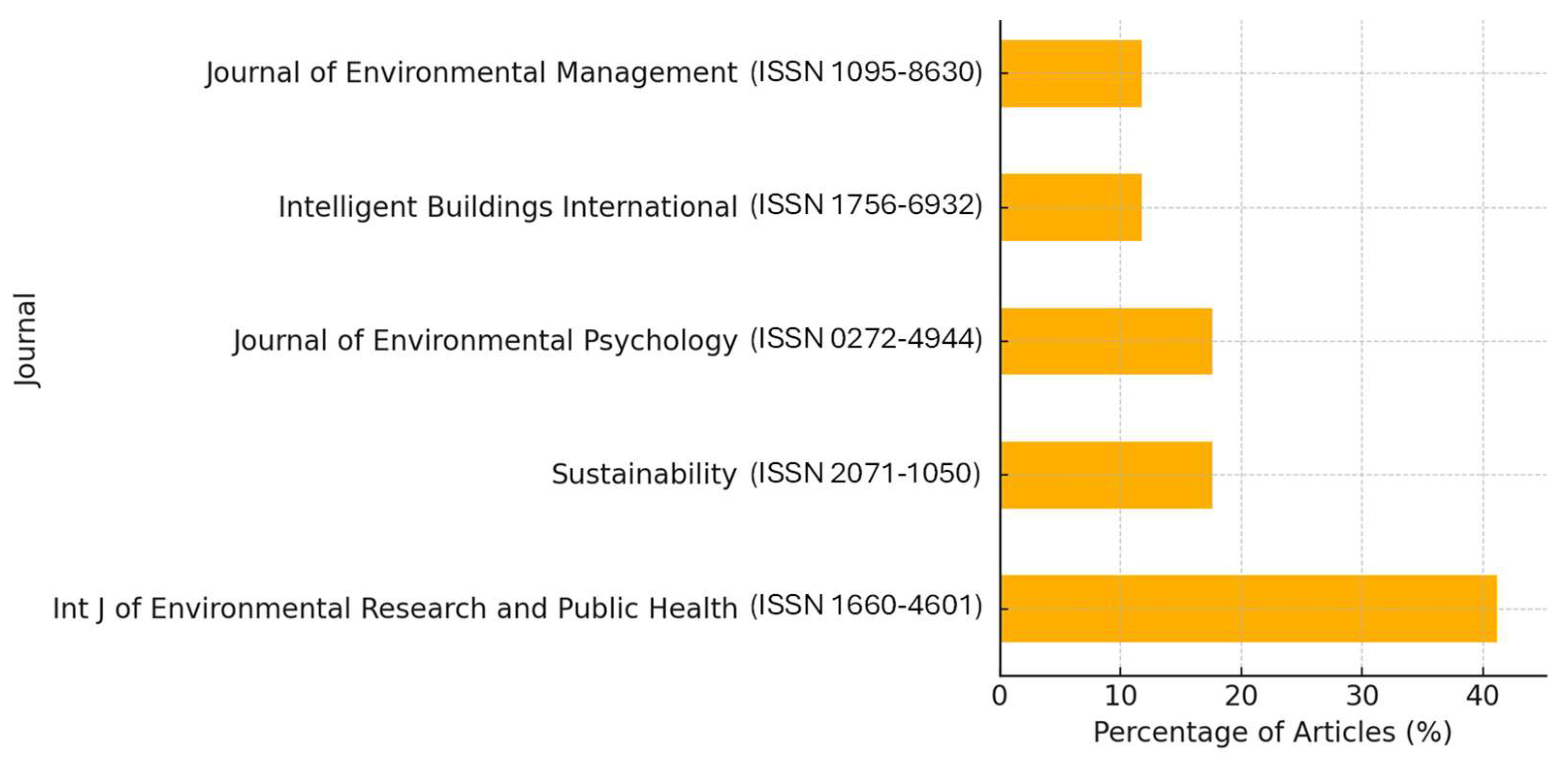
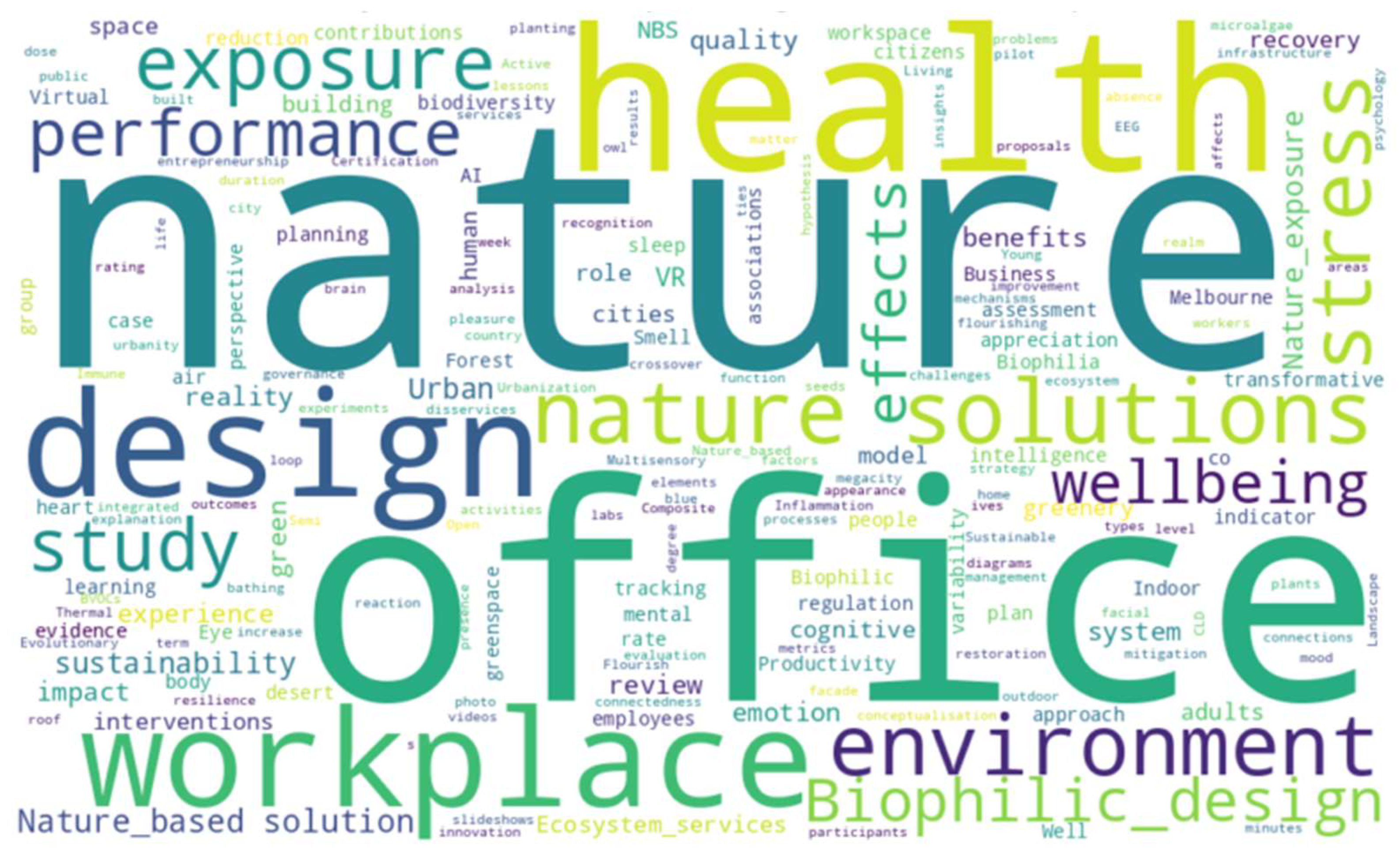
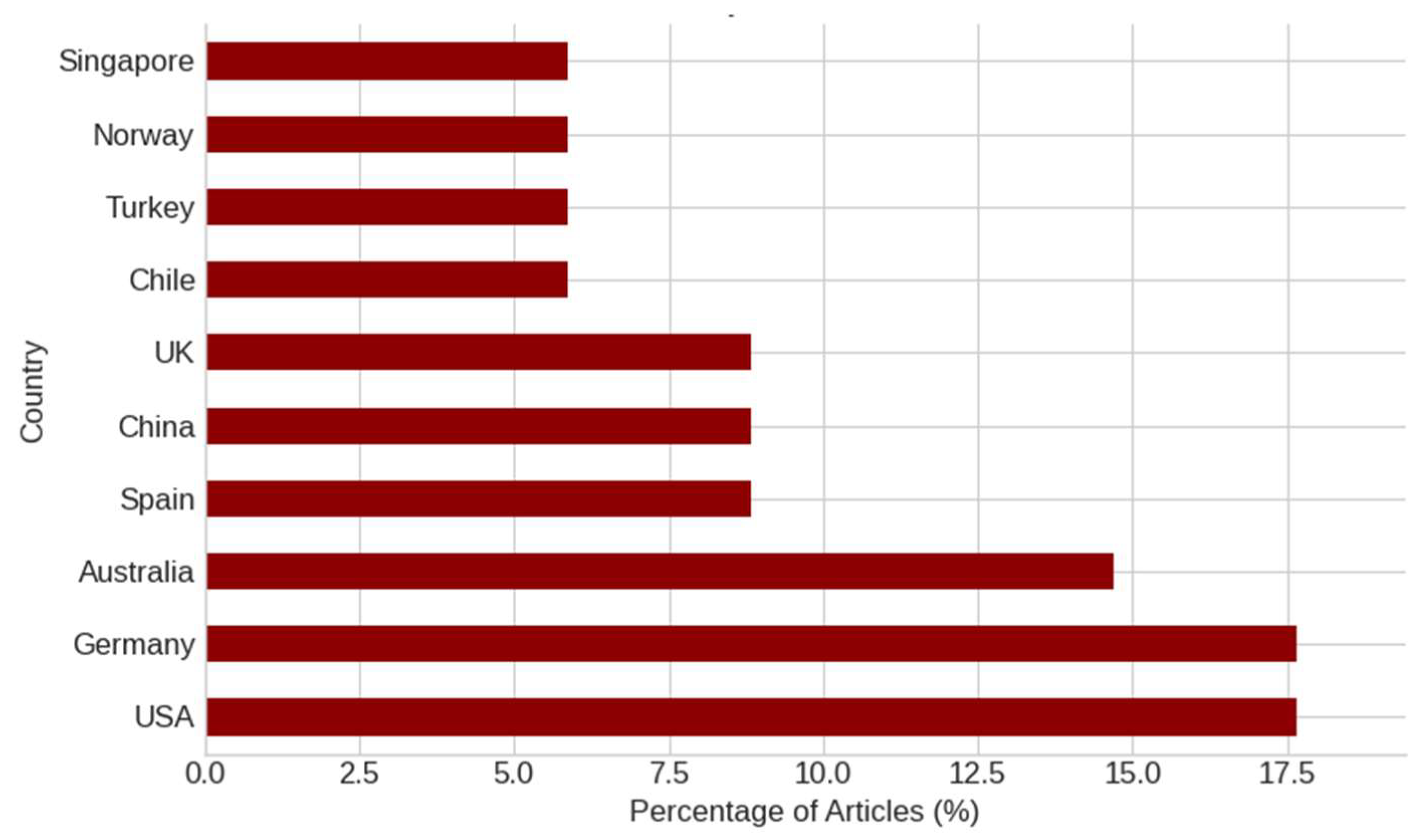

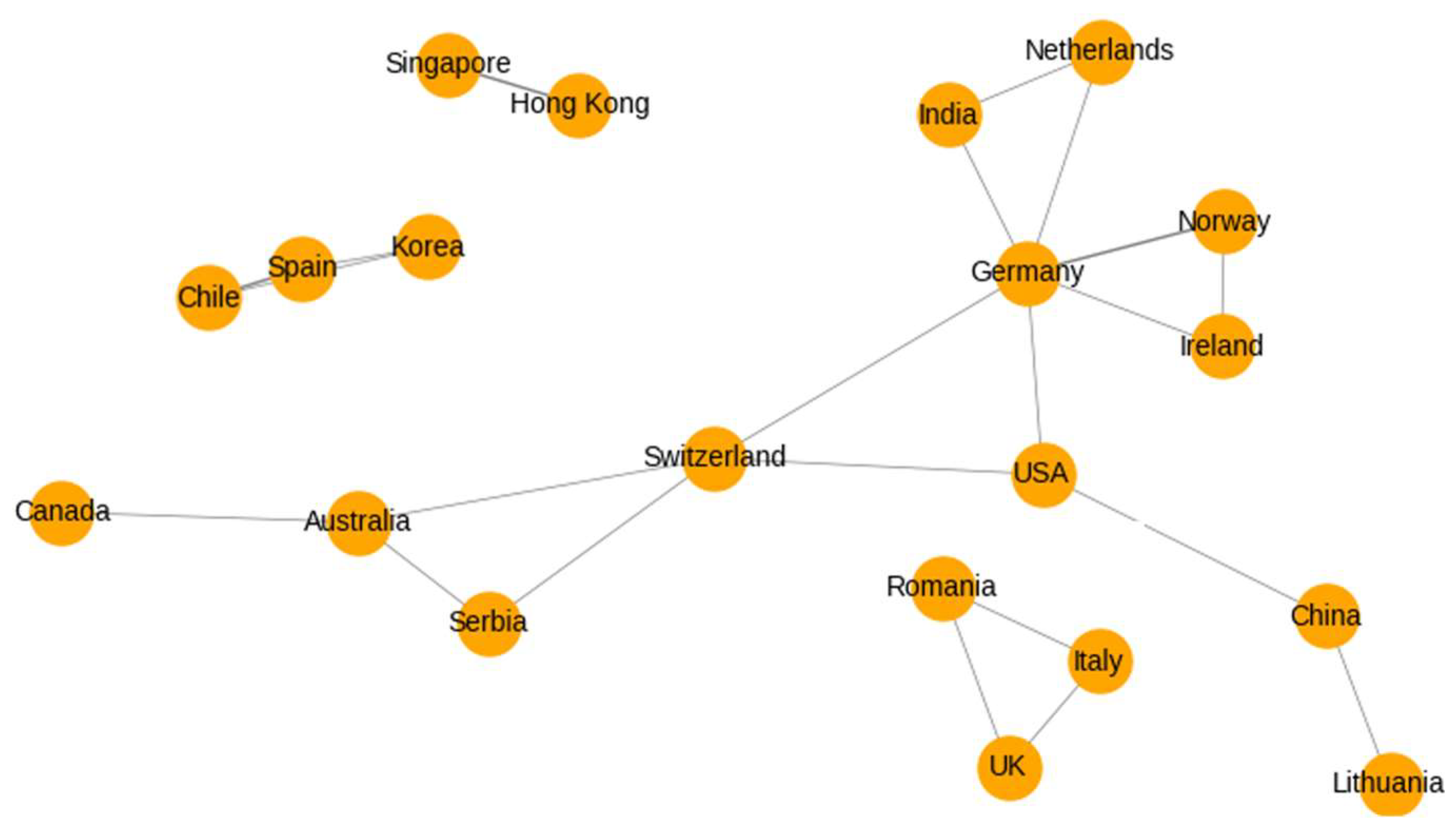

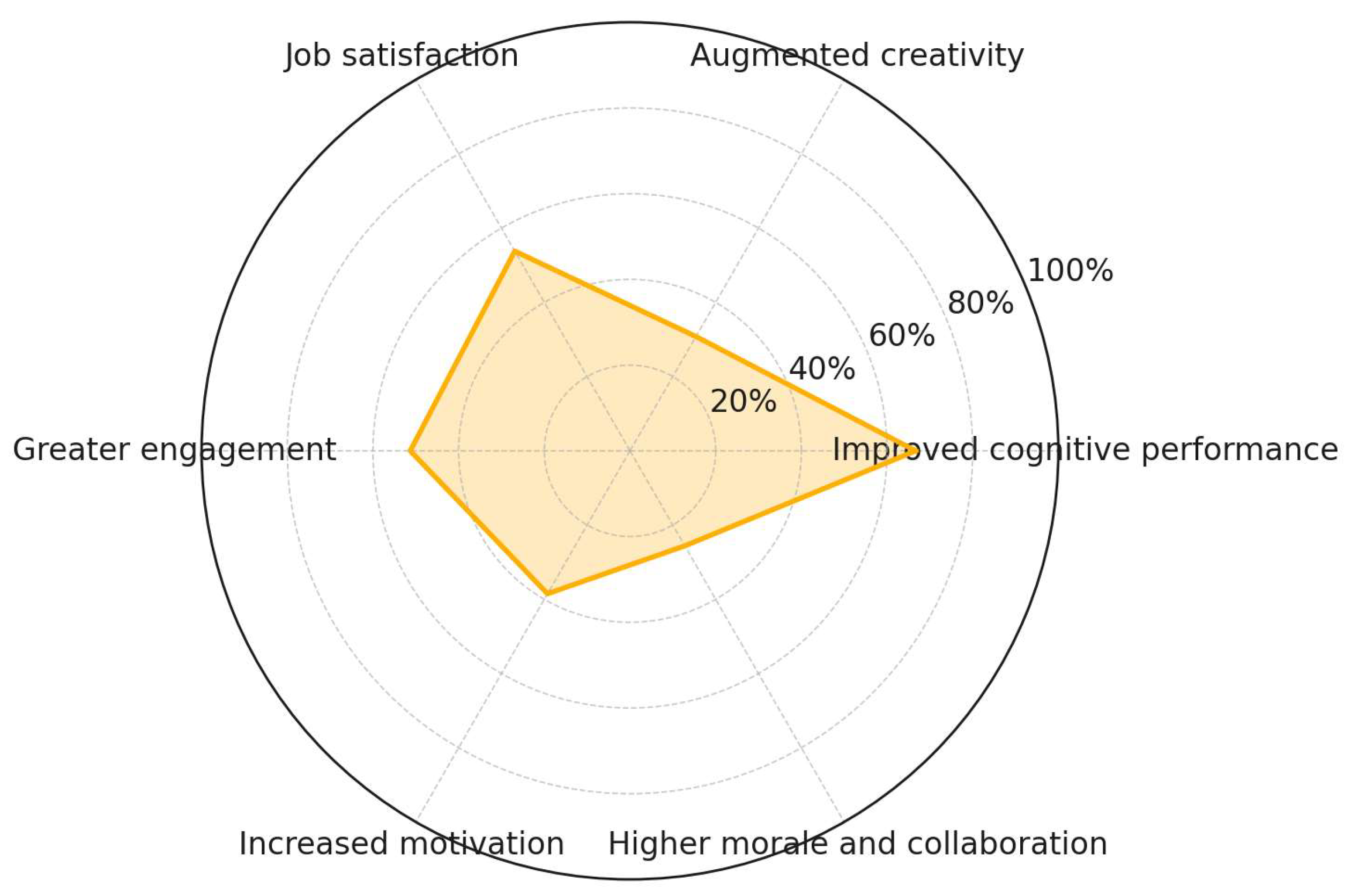

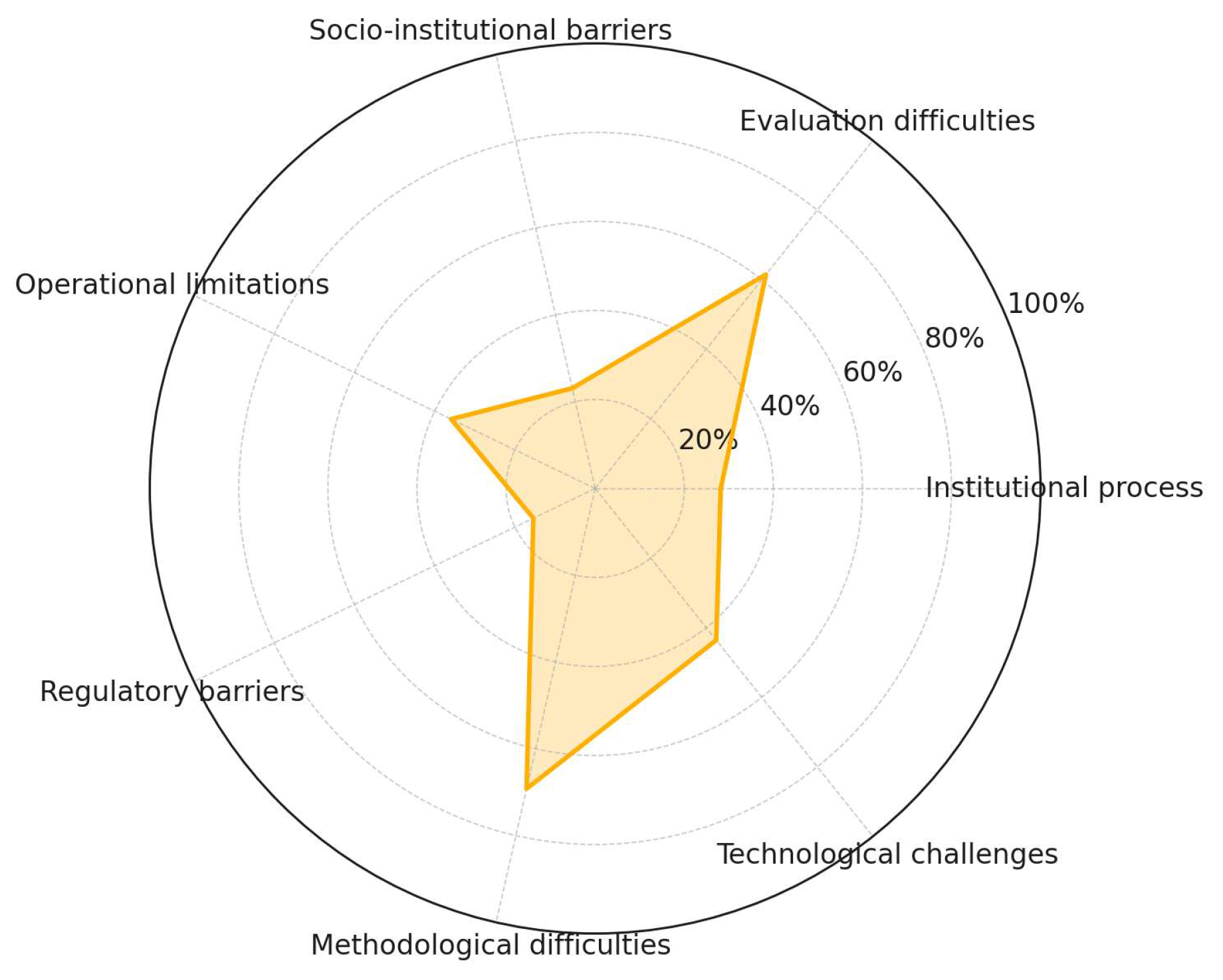
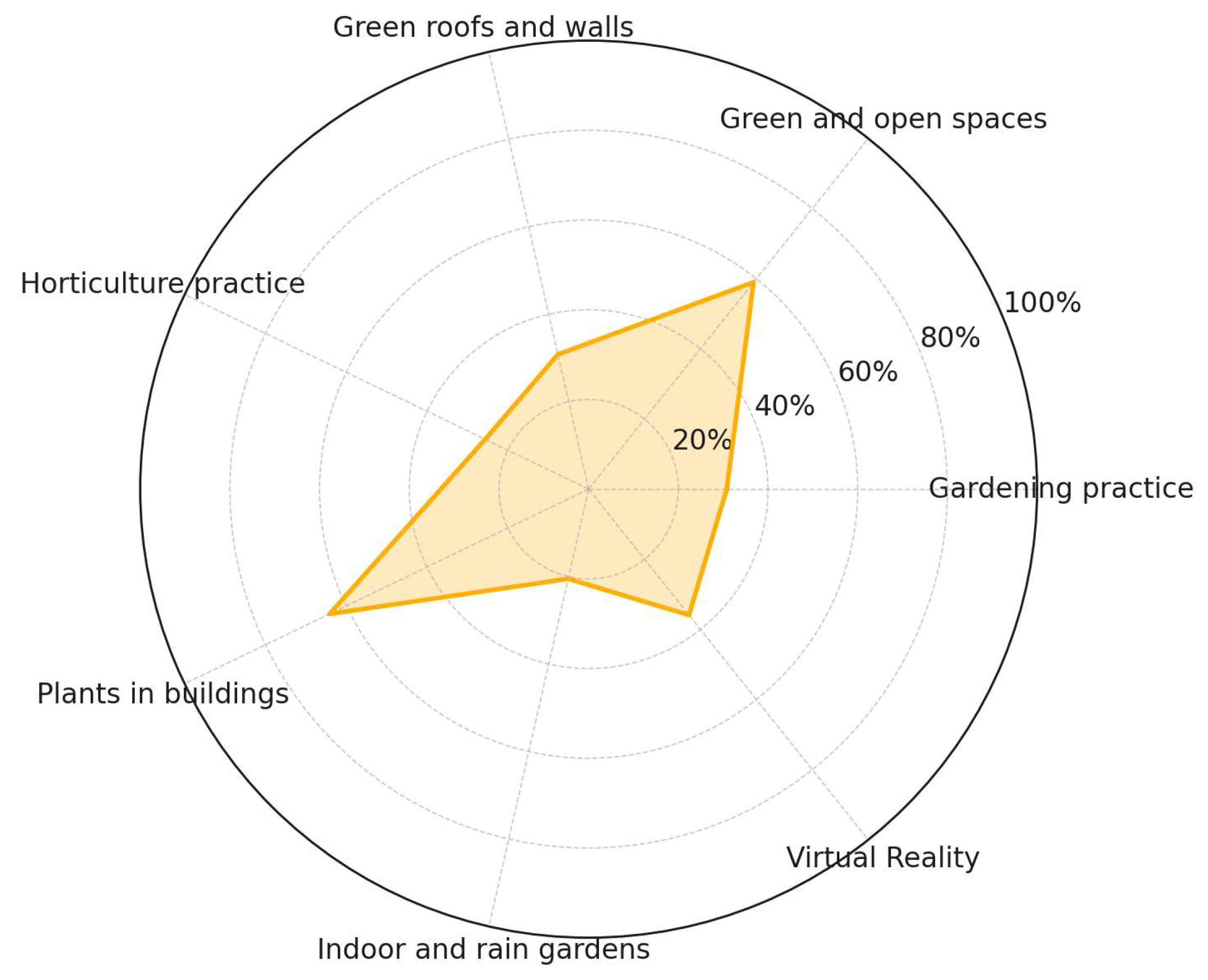
| Category | Term/Combination | Operator |
|---|---|---|
| Nature | “Nature-based solutions”, “Biophilic Design”, “Nature Exposure” | OR |
| Results | “Environmental Quality”, “Health”, “Safety”, “Productivity” | OR |
| Tools | “Nature-based solutions” | OR |
| Filters | 2019–2024, Impact Factor > 1, Search in: Article Title, Abstract, Keywords | AND |
| Term/Combination | Search | Retained |
|---|---|---|
| “Nature-based solutions” OR “Biophilic Design” OR “Nature Exposure” AND “Environmental Quality” | 1221 | 44 |
| “Nature-based solutions” OR “Biophilic Design” OR “Nature Exposure” AND “Health” | 812 | 69 |
| “Nature-based solutions” OR “Biophilic Design” OR “Nature Exposure” AND “Safety” | 242 | 6 |
| “Nature-based solutions” OR “Biophilic Design” OR “Nature Exposure” AND “Productivity” | 177 | 25 |
| Total | 2452 | 144 |
| Total after duplicate removal | 139 |
| Category | Qty. | Retained | Reasons of Exclusion |
|---|---|---|---|
| NbS Benefits | 43 | 30 | Focused on non-occupational contexts (e.g., public parks, residential areas). Lacked quantitative health/productivity metrics. Addressed mental health outcomes without workplace-specific interventions. Superficially mentioned NbSs without empirical validation. |
| Certifications | 1 | 1 | N/A |
| HxN Connection | 1 | 1 | N/A |
| Education | 3 | 2 | Examined academic performance without workplace relevance. |
| Occupational | 21 | 16 | N/A |
| Urban Planning | 42 | 3 | Prioritized city-scale infrastructure (e.g., green corridors) over workplace design. Focused on policy without practical implementation in occupational settings. Addressed flood management without health or productivity co-benefits. |
| Review | 20 | 14 | Broadly discussed NbSs without occupational health or QEHS alignment. Synthesized evidence on ecosystem services unrelated to workplaces. Lacked critical appraisal of NbS implementation barriers in corporate settings. |
| VR | 8 | 13 | Lacked protocols to translate VR nature exposure into design guidelines. |
| TOTAL | 139 | 80 |
| Methodology | % | Application Example |
|---|---|---|
| Systematic Reviews | 25 | Evidence on NbSs and mental health. |
| Experimental Studies | 18 | VR or biophilia interventions. |
| Observational Studies | 22 | Longitudinal data (e.g., cortisol levels). |
| Qualitative Studies | 12 | Interviews on green space perceptions. |
| Data Modeling/Analysis | 23 | Bibliometrics, or machine learning. |
| Total | 100 |
| Reason | % | Example |
|---|---|---|
| Methodological Clarity | 33 | Undescribed methods. |
| Unrepresentative Sample | 17 | 15 participants, no demographic diversity. |
| Confounding Bias | 17 | No control for socioeconomic factors. |
| Non-Significant Results | 17 | Insignificant differences in ROS scale. |
| Off-Topic | 16 | Building certifications unrelated to health. |
| Total | 100 |
| Inclusion Criterion | % | Contribution |
|---|---|---|
| Policy Relevance | 30 | Supports green infrastructure policies. |
| Methodological Innovation | 25 | New tools for psychological assessment. |
| Emerging Evidence | 20 | Solutions for polluted urban environments. |
| Understudied Contexts | 15 | Highlights nature-access inequalities. |
| Interdisciplinary Value | 10 | Integrates architecture and occupational psychology. |
| Total | 100 |
| Category | % | Details |
|---|---|---|
| JBI-Compliant Articles | 88 | Followed strict methodological criteria. |
| Justified “Borderline” Articles | 12 | Included for unique contributions. |
| Total Articles Analyzed | 100 | Complete database. |
| Increased Self-Esteem 1 | Immunological Improvement 1 | Reduced Sick Building Syndrome 1 | Reduction in Mental Exhaustion 1 | Stress Reduction 1 | Augmented Creativity 2 | Greater Engagement 2 | Higher Morale and Collaboration 2 | Improved Cognitive Performance 2 | Increased Motivation 2 | Job Satisfaction 2 | Organizational Improvement 3 | Productivity Increase 3 | Reduced Absenteeism 3 | Reduced Healthcare Costs 3 | |
|---|---|---|---|---|---|---|---|---|---|---|---|---|---|---|---|
| Al Dmour et al. [29] | x | x | x | x | x | x | x | x | |||||||
| Al Khatib et al. [30] b | x | x | x | ||||||||||||
| Aly [27] a | x | x | x | x | x | x | x | x | x | x | |||||
| Andersen et al. [31] b | x | x | x | x | |||||||||||
| Aristizabal et al. [32] a | x | x | x | x | x | ||||||||||
| Ausseil et al. [33] a | x | x | x | x | x | x | x | ||||||||
| Barnes et al. [34] b | x | x | x | x | x | ||||||||||
| Barron and Rugel [35] a | x | x | x | x | x | x | x | ||||||||
| Bressane and Castro [23] a | x | x | x | x | x | x | x | x | |||||||
| Candido et al. [36] a | x | x | x | x | x | x | x | x | x | x | |||||
| Chan et al. [37] a | x | x | |||||||||||||
| Coletta et al. [38] a | x | x | x | ||||||||||||
| Demirkol and Önaç [39] a | x | x | x | x | x | x | x | x | x | x | x | ||||
| Fukano and Soga [40] a | x | x | x | ||||||||||||
| Gritzka et al. [8] b | x | x | x | x | x | x | x | ||||||||
| Hähn et al. [41] b | x | x | x | x | |||||||||||
| Hutson and Hutson [6] b | x | x | x | x | x | x | x | x | x | x | |||||
| Jimenez et al. [42] b | x | x | x | ||||||||||||
| Kumpulainen et al. [43] a | x | x | x | x | x | x | x | ||||||||
| Lei et al. [44] a | x | x | x | ||||||||||||
| Liu et al. [45] b | x | x | |||||||||||||
| Liu et al. [46] a | x | x | x | ||||||||||||
| Lyu et al. [47] a | x | x | x | ||||||||||||
| Özgenç and Özgenç [48] b | x | ||||||||||||||
| Paredes-Céspedes et al. [49] b | x | x | x | ||||||||||||
| Ramm et al. [50] a | x | x | x | x | x | x | |||||||||
| Reyes et al. [51] b | x | x | x | x | x | ||||||||||
| Ríos-Rodríguez et al. [7] b | x | x | x | x | x | x | x | x | |||||||
| Sadick and Kamardeen [10] b | x | x | x | x | x | x | x | x | x | x | x | ||||
| Stork et al. [52] a | x | x | x | x | x | x | x | ||||||||
| Thapa et al. [53] a | x | x | x | x | |||||||||||
| Wallm-Sperlich et al. [54] a | x | x | x | x | x | x | x | x | |||||||
| Wickenberg et al. [55] a | x | x | x | x | x | ||||||||||
| Yildirim [56] a | x | x | x | x | x | x | x | x | x | ||||||
| Yin et al. [15] a | x | x | x | ||||||||||||
| Yin et al. [57] a | x | x | x | ||||||||||||
| Yu et al. [58] a | x | x | x | x | x | ||||||||||
| Zhang et al. [59] a | x | x | x | x | x | ||||||||||
| Zhong et al. [12] b | x | x | x | x | x | x | x | x | x | x | x |
| Evaluation Difficulties 1 | Financial Challenges 1 | Institutional Process Barriers 1 | Methodological Difficulties 1 | Operational Limitations 1 | Regulatory Barriers 1 | Sociocultural Barriers 1 | Socio-Institutional Barriers 1 | Structural Limitations 1 | Technological Challenges 1 | Plants in Buildings 2 | Gardening Practice 2 | Green and Open Spaces 2 | Green Roofs and Walls 2 | Horticulture Practice 2 | Indoor and Rain Gardens 2 | Virtual Reality 2 | |
|---|---|---|---|---|---|---|---|---|---|---|---|---|---|---|---|---|---|
| Al Dmour et al. [29} a | x | ||||||||||||||||
| Al Khatib et al. [30] b | x | x | x | x | x | x | x | x | x | x | x | x | x | x | x | ||
| Aly [27] a | x | x | x | x | x | x | x | x | x | x | |||||||
| Andersen et al. [31] b | x | x | x | x | |||||||||||||
| Aristizabal et al. [32] a | x | x | x | x | x | x | x | x | x | ||||||||
| Ausseil et al. [33] a | x | x | x | x | x | x | x | x | x | x | x | ||||||
| Barnes et al. [34] b | x | x | x | x | |||||||||||||
| Barron and Rugel [35] a | x | x | x | x | x | x | x | x | x | x | x | x | |||||
| Bressane and Castro [23] a | x | x | x | x | x | x | x | ||||||||||
| Candido et al. [36] a | x | x | x | ||||||||||||||
| Chan et al. [37] a | x | x | x | x | x | x | x | x | x | x | x | x | x | x | |||
| Coletta et al. [38] a | x | x | x | x | |||||||||||||
| Demirkol and Önaç [39] a | x | x | x | x | |||||||||||||
| Fukano and Soga 40] a | x | x | x | x | x | x | |||||||||||
| Gritzka et al. [8] b | x | x | x | x | x | x | x | ||||||||||
| Hähn et al. [41] b | x | x | x | x | |||||||||||||
| Hutson and Hutson [6] b | x | x | x | x | x | x | |||||||||||
| Jimenez et al. [42] b | x | x | x | x | x | x | x | ||||||||||
| Kumpulainen et al. [43] a | x | x | x | ||||||||||||||
| Lei et al. [44] a | x | x | x | x | |||||||||||||
| Liu et al. [45] b | x | x | x | x | |||||||||||||
| Liu et al. [46] a | x | x | x | x | x | ||||||||||||
| Lyu et al. [47] a | x | x | x | x | |||||||||||||
| Özgenç and Özgenç [48] b | x | x | x | ||||||||||||||
| Paredes-Céspedes et al. [49] b | x | x | x | x | x | x | x | x | x | x | x | x | x | x | |||
| Ramm et al. [50] a | x | x | x | x | x | ||||||||||||
| Reyes et al. [51] b | x | x | x | x | x | x | x | x | x | x | |||||||
| Ríos-Rodríguez et al. [7] b | x | x | x | x | x | x | |||||||||||
| Sadick and Kamardeen [10] b | x | x | x | x | x | x | x | x | |||||||||
| Stork et al. [52] a | x | x | x | x | x | x | x | x | x | x | x | x | |||||
| Thapa et al. [53] a | x | x | x | x | x | x | x | ||||||||||
| Wallm-Sperlich et al. [54] a | x | x | x | x | x | ||||||||||||
| Wickenberg et al. [55] a | x | x | x | x | x | x | x | ||||||||||
| Yildirim [56] a | x | x | x | ||||||||||||||
| Yin et al. [15] a | x | x | |||||||||||||||
| Yin et al. [57] a | x | x | x | x | |||||||||||||
| Yu et al. [58] a | x | x | x | ||||||||||||||
| Zhang et al. [59] a | x | x | x | ||||||||||||||
| Zhong et al. [12] b | x | x | x | x | x | x | x | x | x | x | x | x | x | x | x |
Disclaimer/Publisher’s Note: The statements, opinions and data contained in all publications are solely those of the individual author(s) and contributor(s) and not of MDPI and/or the editor(s). MDPI and/or the editor(s) disclaim responsibility for any injury to people or property resulting from any ideas, methods, instructions or products referred to in the content. |
© 2025 by the authors. Licensee MDPI, Basel, Switzerland. This article is an open access article distributed under the terms and conditions of the Creative Commons Attribution (CC BY) license (https://creativecommons.org/licenses/by/4.0/).
Share and Cite
de Castro, M.V.; Negri, R.G.; Fiore, F.A.; Bressane, A. Nature-Based Solutions in Workplace Settings: A Scoping Review on Pathways for Integrated Quality, Environmental, Health, and Safety Management. Int. J. Environ. Res. Public Health 2025, 22, 1455. https://doi.org/10.3390/ijerph22091455
de Castro MV, Negri RG, Fiore FA, Bressane A. Nature-Based Solutions in Workplace Settings: A Scoping Review on Pathways for Integrated Quality, Environmental, Health, and Safety Management. International Journal of Environmental Research and Public Health. 2025; 22(9):1455. https://doi.org/10.3390/ijerph22091455
Chicago/Turabian Stylede Castro, Marcos Vinícius, Rogerio Galante Negri, Fabiana Alves Fiore, and Adriano Bressane. 2025. "Nature-Based Solutions in Workplace Settings: A Scoping Review on Pathways for Integrated Quality, Environmental, Health, and Safety Management" International Journal of Environmental Research and Public Health 22, no. 9: 1455. https://doi.org/10.3390/ijerph22091455
APA Stylede Castro, M. V., Negri, R. G., Fiore, F. A., & Bressane, A. (2025). Nature-Based Solutions in Workplace Settings: A Scoping Review on Pathways for Integrated Quality, Environmental, Health, and Safety Management. International Journal of Environmental Research and Public Health, 22(9), 1455. https://doi.org/10.3390/ijerph22091455









